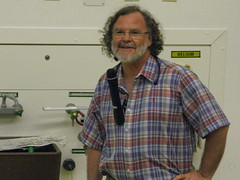
He first reminded us of the danger of a “Whig interpretation of history”, meaning, for instance “to praise revolutions provided they have been successful” (Butterfield). In history of mathematics, this often takes the form of showing how we got where we are today. The problem with this is, of course, that history is not about describing how we got where we are today, but to understand people of the past based on their own context. Fried gave the example of the idea of similarity in geometry, and claimed that while our concept of similarity is a “unified” concept based on transformations of the space, in Greek mathematics, there were separate definitions for different areas of use. For instance, if you wanted to define what it would mean for conic sections to be similar (as Apollonius did), you had to know something about conic sections and define similarity based on the pertinent attributes of the conic sections.
Thus, to teach the history of similarity, we will either have to take the students on a journey a bit longer than the way directly to transformations, or we will have to give a “Whig version” of the history.
So where should we put history of mathematics? That is a strange question, it’s as if history of mathematics is something outside mathematics. To the contrary, history of mathematics is an integral part of mathematics, and the more useful question would be “how do we design a curriculum consistent with a historical view”? (I’ll come back to this discussion when I write about Wednesday’s panel on textbooks.)
Then, Kostas Nikolantonakis and myself had a workshop on “Historical methods for multiplication”. Kostas discussed the method used by Eutocius of Ascalon in his commentary to “The measurement of the circle”. The participants were given the task of translating the numbers from the Greek alphabetic system to the modern numerals. Then we discussed the algorithm compared to the modern one and discussed the situation in schools today. One advantage of Eutocius’ method is that you write down all products in full, instead of having to move one to the left, writing some numbers below and some above and so on, as in the modern algorithm of multiplication.
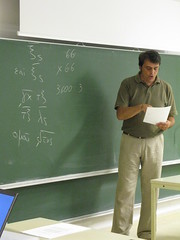
Greek algorithm to the left, a partial translation to the right
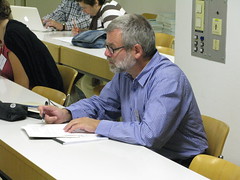
Participant concentrating on the translation
In the second part of the workshop, we discussed the method of “casting out nines”, based on a version of this found in Tyge Hanssøn’s “Arithmetica Danica” (discussed extensively in Geir Botten’s book which was published last year). An interesting insight I got from this is that there are actually two different ways of viewing this algorithms. I have always seen this as concerning “repeated digit sums” (“tverrsum” in Norwegian), where you take the sum of all the digits and then repeat until you have only one digit left. In other countries, as the name “casting out nines” suggest, they do not take the sum of all the digits, but rather remove nine whenever they get above nine. An example: 76292. I would find the repeated digit sum like this: 7+6+2+9+2=26. 2+6=8. Others would do it like this: 7+6=13, that leaves 4 after casting out the nine. 4+2=6. 6+9 = 15, which leaves 6. 6+2 = 8. The methods are obviously equivalent in their result, but feels a bit different.
Anyway, now I’m discussing what I learned from our workshop, not the contents of it. We went on to talk about the history of this method, and in the end spent some time discussing the role of different algorithms in teacher education. Here, I put Deborah Ball (etc)’s model on the wall and discussed that a little.
Then over to the day’s three-hour workshop. Man Keung Siu’s workshop was on “Inscribed square in a right triangle”. Yes, that’s right – we spent three hours inscribing squares in triangles (although not all of them right ones, actually). And I was exhausted afterwards, because the workshop involved so much thinking.
But first, before going on: given a right triangle ABC (where B is the right angle), how would you find a square DEFG such that D=B, E is on BC, F is on AC and G is on AB? (I must admit that at first I solved it using coordinates – which is quite a modern way, of course.)
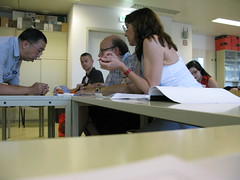
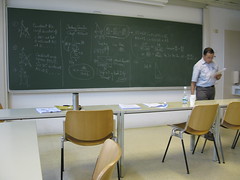
The workshop was based on Chinese solutions of this problem, both before and after the influence of Euclid had come to China. The influence can be seen, as the proofs were changed significantly. However, I will refrain from trying to explain more about this here, as I would surely get lots of the facts wrong – not to mention the names of the Chinese mathematicians and texts.
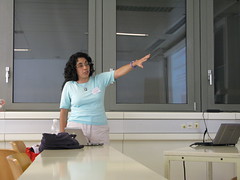

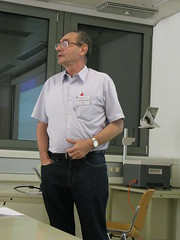
The last part of the day was again devoted to oral presentations. I was the chair of one of the sessions, a role which I choose to interpret as presenting the speaker and then keeping track of the time. With only 30 minutes, including questions and comments, for each speaker, I think they prefer the chair to be brief… The three speakers in this session was Gabriela Buendia Abalos, who talked about the use of the periodic property through history, and how it has evolved out of a need for prediction, Oscar Abdounur (stepping in for Adriane Cesar de Mattos) on a paper of George Boole and finally Gérard Grimberg, on the development of the geometric interpretation of complex numbers. Of course, I was interested to see which role Caspar Wessel’s work on complex numbers would get in this last talk, both because it was long overlooked and because it is – as Grimberg noted – not as much a geometric interpretation of complex numbers as a analytical representation of geometric objects. (Wessel’s background was in surveying, of course.)
That marked the end of the second day of the conference, one might imagine. No! There was a meeting at eight o’clock. The Advisory Board of the HPM (in which I am a member in my role as Newspaper editor) had a meeting/dinner. As usual in these meetings, it is a bit difficult for the people at one end of the table to hear what the people at the other end of the table say, so many of us were a bit curious as to what had been decided. I’m joking, of course – moreover, the Advisory Board does not decide things. The chair of the HPM makes decisions, after seeking advice in the Advisory Board.
An example of a topic discussed was whether the next HPM meeting (in Korea in 2012) should have its proceedings published before or after the conference. I think it was decided that they should be available before the conference. At my end of the table, we discussed whether it could then be called “proceedings”, and I proposed “preceedings”. Anyway, there are many advantages to having “preceedings”: for quality control, making it easier to find talks and workshops you’re interested in, making it possible to read contributions you can’t attend and then talk to the person at the conference instead of having to do that one year later. For many, the “preceedings” will not be the final publishing of the paper, as they will revisit the paper after the conference and then send an improved version to some journal or other.
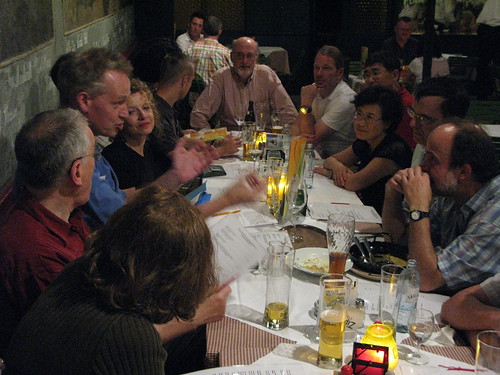
The food was delicious, by the way.




No comments:
Post a Comment